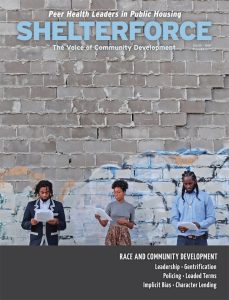
Topic
Community Development Field
Shelterforce considers “community development” to be an extremely broad term. But there are still many conversations about the ways in which that broad work happens. Comprehensively or in coalitions of specialized organizations? Locally or regionally? Place or people? While the answers to all of these are usually “both,” there are many conversations to be had about “how.”
The Latest

Are Insurance Problems on the Horizon for Community Development Groups?
A mistaken cancellation letter to a national membership organization might indicate trouble to come for on-the-ground community development organizations.
Explore Articles in this Topic
Search & Filter Within this Topic
filter by Content Type
filter by Date Range
search by Keyword

Industry versus Movement – Redux
Three years ago, I posted a blog in which I wrestled with the question of whether community development is an “industry” or a “movement.” That was the sort of insiders’ […]

Police and Communities: Conversations Continue, Solutions Appear
Community development corporations play an important role in community safety. As such, they are often at conflict with themselves over their relationships with the police and the communities they serve.

When a Person’s Character Trumps Their Credit Score
Some CDFIs approve loans based on a person’s character instead of their credit score. But they only recommend
doing so when you know the applicant.

Preparing a Career Path for Community Change Agents
College credentials combined with local organizing experience helps create a new generation of community activists.

Editor’s Note: Racial Justice — Beyond Good Intentions
Race affects everything in American society. Working to fight racial injustice is a large part of what the community development field does. And yet, that doesn’t get us off the hook.

Who Will Lead Community Development Corporations?
Community development corporations are surprisingly short on executives of color. Why? And how can the field do better?

Roundtable: Policing and Community Development
Many people in the community development field are conflicted about the police presence where they work. We invited a group of practitioners to share their experiences and talk through this tension.

Chipping Away at Implicit Bias
Structural discrimination has led to an unconscious association between blackness and poverty and neighborhood disinvestment. Here’s what we can do to change the status quo.

CDFIs Led By People of Color Face Financial Disparities Too
A lack of access to capital, capacity-building resources, and technical assistance significantly constrains the ability of CDFIs led by people of color to achieve greater impact.

Measuring What Really Matters in Community-Based Development Organizations
Developing a road map for performance improvement within CBDOs can be a daunting task, and while their missions are sometimes nebulous, here are some ways to measure them.

Terrorism in Charlottesville — And Possibly Your Town Next
The Trump-era increase widespread racial terror, as was on display in Charlottesville, is going to affect community developers’ work at least as much as as his legislative and funding agenda.

SoFi, Not So Good: Is This Virtual Redlining?
SoFi is practicing product segregation. It wants to serve affluent people with its best products and shunt low- and moderate-income borrowers into inferior products that do not meaningfully serve credit needs.
